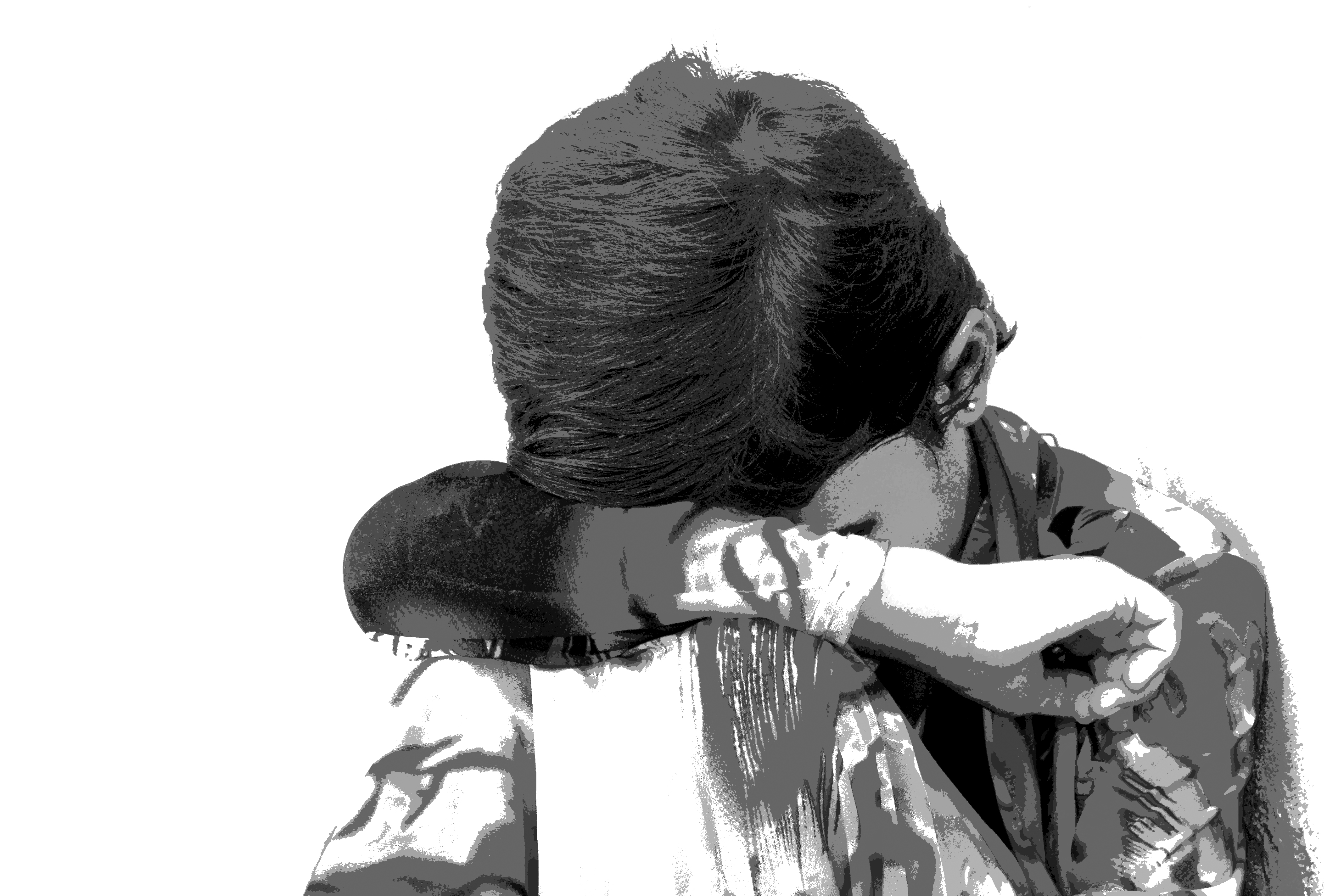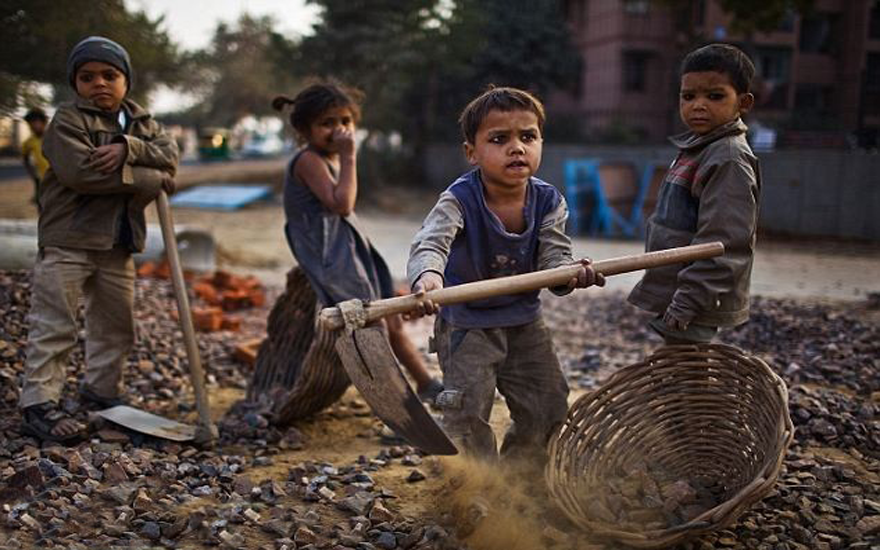Violated Innocence
By Semra Khalid | Special Report | Published 11 years ago
At approximately 9am, Qamar Munir makes his way from his modest apartment behind the Finance and Trade Centre in Karachi to the offices of Roshni Helpline, a local NGO in Gulshan-e-Iqbal. Dressed in a brown safari suit, Qamar, once a jovial man, takes short, cautionary steps. Now 63, he has been following this routine every day since 2009, a couple of years after his 12-year-old son Ahsan — who had gone missing in 2001 — returned home unexpectedly in November 2003.
Qamar’s wife had fainted upon seeing her son. His appearance was remarkably different: sporting multiple ear piercings and dressed in a long white flowing kurta that almost reached his ankles, her son, now 14, offered a stark contrast to the unassuming 12-year-old who had left for the madrassa early that fateful morning in 2001 only to never return home. The twists and turns his life had undertaken in those two years are still relatively hazy and largely a secret to the family. The most Qamar knows is that Ahsan was ‘traded’ by multiple gangs that employed him for a wide range of criminal activities — from smuggling drugs to the Northern Areas, to begging at Data Darbar in Lahore.
According to Mohammed Ali, owner of Roshni, which is handling cases of missing children like Ahsan, the issue of missing children in Pakistan is a “severely neglected one.” A rangy man, Ali has worked on human rights issues of women, children and ethnic minorities for more than 20 years, and in 2006 he set up Roshni Helpline. He says a child is deemed missing when he/she has lost contact with the guardians and his/her whereabouts are unknown to them. Additionally, the circumstances indicate that the child did not leave the custodian voluntarily and neither was it authorised by law.
In 2012, more than 1,960 children were reported missing in Karachi. In 2011, 2,212 children were reported missing and in 2010, the figures were particularly staggering: 3,090 missing children. Karachi has 110 police stations, and in about 106 of these, an average of two children have been reported missing in the past one year alone. These are the officially listed figures; many missing children do not make it to the police files.
A popular alternative to the police station is the local mosque, where the presiding maulvi announces the name of the missing child over the loudspeakers and describes the appearance of the child at the time of disappearance. An average of three announcements were made from each of the 342 mosques in Karachi every month, bringing the total number of missing children in 2011 to 8,712. This means that approximately 6,500 children were either unreported by families or largely unacknowledged by police authorities.
A typical case of a missing child is treated by police authorities as a ‘non-cognisable’ offence which, in legal terms, basically means an offence in which the police is not liable to register an FIR; only a kachhi FIR — a report that has no legal implication — can be lodged. In such cases, the initial help the local police offers is a wireless radio call to other police mobiles around the city transmitting details of the missing child. If the police were to register a proper FIR as soon as a child is reported missing from an area and proceed with the necessary investigations, chances are the perpetrators would not be able to venture further out of the abduction area and could possibly be traced and captured. However, the reality is totally different.
When Qamar’s son Ahsan did not return home on that fateful night, Qamar went to the Saddar police station to lodge a complaint at around 1am. The officer on duty brushed his apprehensions aside, insisting that Ahsan could be at a friend’s or relative’s place. Qamar returned to the police station every single day for a week, but to no avail. Eventually, the family sought help from some local NGOs. When that too proved unsuccessful, they turned to a pir, who in actuality was a local factory worker, who had duped several unsuspecting victims similarly by charging a hefty fee for services not rendered. From living in an 18-square yard plot, the pir now resides in a bungalow and has a car at his disposal.
An FIR was finally registered — nine months later — and Qamar had to pay for the police officers’ lunches, dinners, tea and even fuel every time he accompanied them on their search for his missing son.
Mohammed Ali warns that missing children are likely to fall prey to one or more of the following crimes: trafficking, which includes both buying and selling of children to other areas for various purposes, namely forced labour, slavery, sexual exploitation such as prostitution or rape, and adoption.
Ali strongly believes that some children could be prime targets of potential kidnappers because of the problems they face at home or in school, or simply due to general parental negligence that raises their vulnerability and clouds their judgment. Ahsan, for instance, told his family that occasionally he had been beaten at the madrassa. So it’s possible that he ran away from home to escape the madrassa, but fell victim to a kidnapper.
Sara’s is a similar tale. She was raped by her biological father when she was just 10 years old and ran away at age 13, with the intention of ending her life. She was saved by a man who she then married, and bore three children, two boys and a girl. Though he saved her life, her husband was a drug-addict, so she left him and remarried a year later. One day, she walked in on her second husband just as he was about to sexually molest her four-year-old daughter. Shaken by the situation at home, her two boys, Awais and Naveed, aged 11 and six respectively, ran away early one morning in May 2011. They began serving tables at Abbasi Shaheed Hospital, until one afternoon when they were kidnapped by a middle-aged couple.
Ali believes that some children could be prime targets of potential kidnappers because of the problems they face at home or in school, or simply due to general parental negligence that raises their vulnerability and clouds their judgment. Ahsan, for instance, told his family that occasionally he had been beaten at the madrassa. So it’s possible that he ran away from home to escape the madrassa, but fell victim to a kidnapper.
Awais was taken to Sohrab Goth and thrown in an empty plot, full of trash and other vagabond children. He was forced to work in a printing factory 12 hours a day, in order to earn money to pay for the male kidnapper Iqbal’s hernia operation. The couple kept the Naveed with them, locked in a room in their house, to ensure Awais’s compliance. He was fed a meagre dinner and sometimes breakfast. Both children were made to sleep on the hard floor at night with little or no light. Iqbal would drive a taxi in the afternoons and sometimes bring back a “sack of children” to the plot in the evenings. Awais recalls how once a tall, fair man in a collarless black kurta paid some money to the couple, cradled a wailing child in his arms and took him away.
The brothers were finally released five months later, dropped in front of Edhi Centre at Sohrab Goth, but not before the couple had collected the Rs 25,000 needed for Iqbal’s operation.
Meanwhile, Rasheed’s 15-year-old sister Nasreen had been missing from the residence of her employer in Defence, where she had been working for over a year. Conflicting testimonies of the parties involved suggest she may have been sold for prostitution.
When I met Rasheed, he looked haggard; his eyes were blood shot and his sentences were incoherent. He told me that when his sister went missing he went to the police station in Defence to lodge a complaint only to be shooed away by the police who said that since he resided in Korangi his case should be filed there. When he went to the Korangi station, he was told to go back to the one in Defence because that was where Nasreen had disappeared from.
This back and forth went on for a week, and Rasheed went berserk.
Nasreen’s FIR was registered nine months after her disappearance. Her case was transferred three times to different police stations due to inadequate investigation. Rasheed realises that his sister could possibly be a victim of sex trade, but he still wants to know what happened to her, although she would now be bekaar (useless) for the family, he tells me softly.
I walked into the notorious Mobina police station, a ram-shackled, three-room setup. The SHO’s office was like a king’s den, complete with an adjoining bedroom. Inside lay a neatly folded single bed, a 32-inch TV, a couch and a coffee table. A pressed police uniform hung over the bed. A couple of minutes later Saleem-Ullah Qureshi walked in, in a light blue kurta. A large man, with a genial manner and a melodic voice, he seemed anxious to please.
Saleem-Ullah had his complaints with the system. He preferred Musharraf’s devolution of powers of the police force whereby a department was divided into operational and investigative sections. Operational officers would only perform paperwork duties such as registering the FIR and recording the data and pass on the case to the investigative officer who would then strictly focus on the groundwork required to solve a case. The aim of this step was to increase the efficiency of an officer. He also mentioned lack of sophisticated technical support; inadequate investigative tools to collect forensic evidence, enhanced investigative equipment such as phone tapping and bugging facilities and CDR (Call Detail Record). CDR is a surveillance technology that police officials in Gurgaon, India, claim has solved 90% of the crime cases.
“Sometimes, the victims can be possible offenders,” says Mohammad Ali. An elderly couple hailing from the Seraiki Belt arrived at Roshni one afternoon to file a report regarding their 13-year-old daughter, who they suspected had been abducted from their house. They brought along a picture of the girl, who looked at least 21 years old, if not more. Ali smelt a rat. Initially claiming they did not suspect anyone, they were tempted by Ali’s bait of immediate recovery. They claimed they knew the mother of the kidnappers and possibly the culprits too. Mohammed suspects they had sold their daughter at a bargain price and probably regretted it later because they received a more lucrative offer.
Nine-year-old Nandini had been missing from Liaquatabad since 2009. Her case was widely ignored by the police. An appeal pressing for an investigation was eventually made to the Chief Justice Sindh, and the girl was subsequently recovered from a brothel in Korangi, along with a number of other Hindu girls who had been reported missing for some time.
Pakistan ratified the United Nation’s Convention on the Rights of the Child (CRC) in December 1990. It was the sixth country in the world and the first among the Muslim countries to ratify the CRC. However, these conventions are not enforceable in Pakistan, until the parliament passes specific legislation making them the law of the land. Additionally, being a federal republic, every province has separate legislation and different provisions apply to different provinces. The National Commission for Child Welfare and Development (NCCWD) is the local body responsible for implementation of the CRC.
In 2011, the Child Rights Movement in Pakistan, an umbrella group of NGOs working to promote rights for children, protested the lack of enforcement of the CRC within provinces of Pakistan. In fact the UN had expressed concern over Pakistan’s weak legislation regarding protection of child rights over the years.
In early 2011, Roshni Helpline filed Pakistan’s first constitutional petition in the Sindh High Court, expressing its concern over the treatment of the issue of missing children as a non-cognisable offence and the inordinate delay by the police in registering an FIR. After the hearing of this petition, the respective judges had issued notices to the Chief Secretary Sindh, Raja Muhammad Abbas, then IG Sindh Police, Wajid Ali Khan Durrani, and then Home Minister Sindh, Zulfiqar Mirza, to appear in court and submit their comments, which they have failed to do and the petition is still pending.
Meanwhile, Justice Bajwa of the Sindh High Court had passed an interim order stressing on prompt registration of FIRs following the filing of the petition, but Advocate Naveed, Roshni’s representative in court, maintains that the police have not followed the interim orders.
Naveed is currently overseeing the case of five-year-old Meena, who belongs to the Hindu community living in Dost Mohammed Goth. The little girl is a rape survivor.
On 26 February, 2011, she had left her hut to run an errand. She was abducted by two brothers, aged 22 and 19, and then brutally raped. She was discovered nearly 1km from her house. Since her internal organs were damaged, she was taken to the Abbasi Shaheed Hospital but the hospital turned her away citing ‘lack of equipment.’ Then she was taken to Civil Hospital in a critical condition, where she was kept waiting for over an hour. Mohammed Ali discovered the little girl there and whisked her off to Aga Khan Hospital where she was treated and her medical bills of four lakh rupees were mainly covered by donations. The culprits were captured and jailed, but have yet to receive the verdict. The case has been in the trial court for the past seven months.
Meena is now confined to her hut, where she plays with a pet kitten. The Goth where she lives is a colourful place; the Hindu community here mainly sell fruits and vegetables for a living. Small mountains of ripe green mangoes are piled high in obtuse corners and a forlorn cow stands in a hut tied beside a bed. Children, some naked, play in the dark; a pungent smell of leaves and cow dung hung in the air. A slight, dark-complexioned girl, Meena flinches as I move to shake her hand. Someone passes me a medical report as I sit on the hard bed.
Meena’s principal diagnosis is perineal laceration grade 3 due to sexual abuse. In layman’s terms, this occurs when the bladder collapses into the roof of the vagina. Meena’s mother tells me that initially Meena was both defecating and urinating through her vaginal opening. Prior to her recovery, Meena had silently walked her family to the empty plot were she was raped. With enough recollection of the ghastly trauma but little understanding of it, her young mind can decipher little from the incident. But it remains there in the dark recesses of the subconscious, making some confusing entries into the conscious.
 In 2011, Roshni filed Pakistan’s first constitutional petition in the Sindh High Court, expressing its concern over the treatment of the issue of missing children as a non-cognisable offence and the inordinate delay by the police in registering an FIR. After the hearing of this petition, the respective judges had issued notices to the Chief Secretary Sindh, Raja Muhammad Abbas, then IG Sindh Police, Wajid Ali Khan Durrani, and then Home Minister Sindh, Zulfiqar Mirza, to appear in court and submit their comments, which they have failed to do and the petition is still pending.
In 2011, Roshni filed Pakistan’s first constitutional petition in the Sindh High Court, expressing its concern over the treatment of the issue of missing children as a non-cognisable offence and the inordinate delay by the police in registering an FIR. After the hearing of this petition, the respective judges had issued notices to the Chief Secretary Sindh, Raja Muhammad Abbas, then IG Sindh Police, Wajid Ali Khan Durrani, and then Home Minister Sindh, Zulfiqar Mirza, to appear in court and submit their comments, which they have failed to do and the petition is still pending.
A case such as this, where the victim is a child, warrants a judicial system that caters to the sensitivities that are associated with it. In developed countries, the trial and investigation systems for cases involving minors are separate.
In Pakistan, a judge who is handling a case of sexual assault of a minor is also handling cases of murder, divorce and theft simultaneously. Furthermore, such cases are treated as crimes against the state. The prosecution lawyer is provided by the state and is, in most cases, inexperienced compared to the defense lawyer, which, in turn, could affect a just conclusion of legal battles. Furthermore, the understaffing of judges and the daily failings in the country’s political structure often divert the attention of the justice system from other crucial social issues. Lack of witness protection programmes and delaying tactics of the defence lawyers all contribute to the delay in the deliverance of justice. High profile political cases are given top priority while the cases of the thousands of children exploited and abused every year are put on the back burner.




